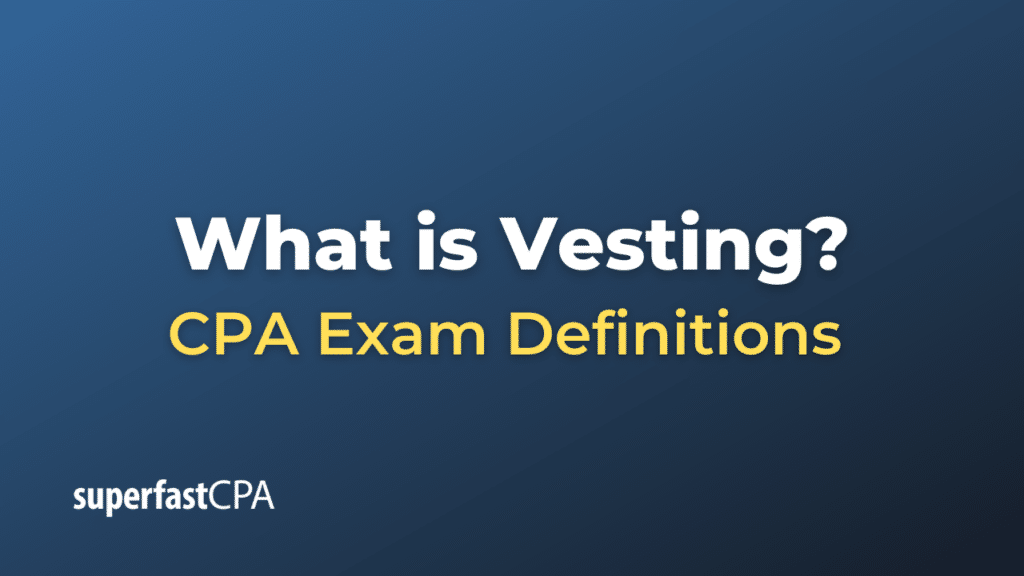Vesting
Vesting refers to the process by which an employee gains full ownership of certain benefits or assets over time. In the context of retirement accounts, stock options, or other types of employee benefits, vesting determines how much of these benefits belong to the employee at any given point in time. Before an employee is fully vested, they do not have the complete right to the full amount of the asset or benefit, although they may have some partial ownership.
Types of Vesting
- Immediate Vesting: Employees gain 100% ownership of their benefits immediately. This is less common and typically applies to simpler benefits like matching contributions in a Simplified Employee Pension (SEP) plan.
- Cliff Vesting: Employees gain 100% ownership of their benefits all at once after a specific period of service. For example, an employee might be 0% vested for the first three years and then become 100% vested all at once after completing the third year of employment.
- Graded or Gradual Vesting: Employees gain a certain percentage of ownership over a series of years. For example, an employee might become 20% vested after the first year, 40% after the second year, and so on until reaching 100%.
- Rolling Vesting: Similar to graded vesting, but instead of vesting percentages changing at yearly intervals, they change more frequently, such as monthly or quarterly.
Common Scenarios
- Stock Options: Employees may be granted stock options that vest over a certain period. Until the options are vested, employees cannot exercise them to buy company stock.
- Retirement Plans: In a 401(k) or similar retirement plan, employer contributions may vest over time, meaning employees can only take the full amount with them if they leave the company after they are fully vested.
- Profit-Sharing Plans: Some companies offer profit-sharing plans that are subject to vesting schedules, so employees have to stay with the company for a certain period to fully benefit from these plans.
Example of Vesting
Let’s dive into an example using a 401(k) retirement plan with a graded vesting schedule to illustrate the concept of vesting.
Company and Employee Profile
- Company: “HealthyTech,” a healthcare technology company
- Employee: Sarah, a software engineer
- Retirement Plan: 401(k) with employer match
- Vesting Schedule: Graded vesting over 5 years
Graded Vesting Schedule
HealthyTech’s graded vesting schedule for their 401(k) employer match is as follows:
- End of Year 1: 20% vested
- End of Year 2: 40% vested
- End of Year 3: 60% vested
- End of Year 4: 80% vested
- End of Year 5 and beyond: 100% vested
Employer Match
HealthyTech offers a 5% employer match. If Sarah contributes 5% of her $100,000 annual salary ($5,000), HealthyTech will also contribute $5,000 into her 401(k) account.
Vesting Over Time
Let’s see how Sarah’s vesting status affects her entitlement to the employer match:
- End of Year 1:
- Sarah is 20% vested.
- Of the $5,000 employer match, she’s entitled to $1,000 (20% of $5,000).
- End of Year 2:
- Sarah is 40% vested.
- Of the $5,000 employer match, she’s entitled to $2,000 (40% of $5,000).
- End of Year 3:
- Sarah is 60% vested.
- Of the $5,000 employer match, she’s entitled to $3,000 (60% of $5,000).
- End of Year 4:
- Sarah is 80% vested.
- Of the $5,000 employer match, she’s entitled to $4,000 (80% of $5,000).
- End of Year 5 and beyond:
- Sarah is 100% vested.
- She’s entitled to the full $5,000 employer match.
If Sarah were to leave HealthyTech after 2.5 years, she would only be entitled to take $2,000 (40% vested) of the employer match with her. The remaining $3,000 would go back to the company’s pension fund.
This example demonstrates how vesting incentivizes employees to stay with a company for a longer period to fully benefit from programs like retirement plans.













